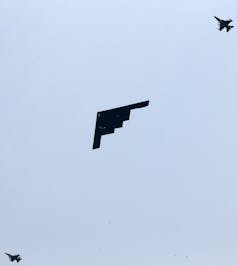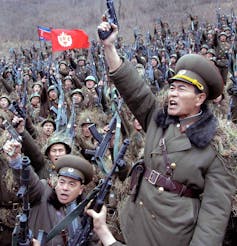Western commentators seem generally mesmerised by North Korea’s quixotic behaviour. The country’s leader, Kim Jong-un, is described as “delusional”, “fruitcake”, “reckless”, and the actions of North Korea’s political/military elite as “aggressive”, “defiant” and “devoid of logic”. Such epithets explain little.
Even today, Fairfax Media describes North Korea’s most recent threat of “merciless” military strikes against the United States using potentially “cutting-edge” nuclear weapons as “lurid”.
To recap briefly on recent tensions: in December 2012 North Korea successfully launched another satellite into orbit, followed in February of this year by a third nuclear test, said to be twice as big as the 2009 test. Thereafter, the acrimony on both sides has steadily intensified.
With South Korea and the United States in the midst of joint military drills, Pyongyang declared on March 12 that the 1953 Korean War armistice was nullified. A few days later the Pentagon announced a major expansion of projected antiballistic missile interceptors along the Pacific Coast, a dangerous move if for no other reason that China itself might see it as aimed at neutralising its own deterrent.
On March 22, North Korea threatened to attack US military bases in Japan and the Pacific island of Guam in retaliation for training missions by US B-2 bombers over South Korea.

The United States responded yet again by signing an agreement with South Korea regarding possible US involvement in “local clashes and skirmishes”. Three days later it dispatched two nuclear-capable B-2 stealth bombers on a practice sortie over South Korea, by which time North Korea had cut off the remaining military hotline with South Korea.
Today, North Korea announced that it had ratified a law authorising plans for “counter-actions” against US aggression, including use of a “lighter” nuclear strike. In response, the US have moved an advanced missile defence system to Guam.
What are we to make of this unnerving sequence of events? One possible interpretation is that North Korean leaders decided to create yet another crisis only to offer to defuse it at a later date in exchange for the energy and food aid the North Korean economy sorely needs. There is evidence to suggest that earlier crises have followed a similar pattern, which may help to explain the periodic rise and fall of tensions.
But such an explanation fails to address two closely related questions: one involving the timing of the latest round of sabre rattling, and the other the fury with which it is conducted.
One thing is clear: North Korea, regardless of its belligerence, lacks the means to defeat South Korea, or to inflict any military damage on the United States.
The motive therefore lies not in the execution of any military threat but in the theatre of threat-making. The prospect of extracting international aid can only be part of the motivation. There is, after all, no guarantee that such aid will be forthcoming even if North Korea should ease its threatening posture. Even if sanctions were relaxed or if some aid did come North Korea’s way, Western economic assistance is likely to be limited, temporary or subject to potentially unacceptable conditions.
Other considerations - each relating to a different audience - have almost certainly influenced the thinking of Kim Jong-un and his associates.
There exists a perceived need to convey a clear message to the people of North Korea: the regime is strong and stable; the new leader may be youthful and inexperienced, but North Korea’s determination to expand its military capabilities is undiminished.

Pyongyang moreover wants its principal adversaries - South Korea and the United States - to be left in no doubt that it is fully determined to thwart any attempt at regime change. Developing a limited but credible nuclear deterrent is crucial to this purpose.
The final - and maybe the decisive - factor is that Pyongyang is signalling to Beijing that declining Chinese support will mean increasing North Korean belligerence. The net effect will be even higher levels of insecurity in northeast Asia, likely to be highly damaging to Chinese interests.
North Korea’s defiant posture is also likely to provoke an expanded US military presence in the region, and this cannot be to China’s liking. Simply put, Pyongyang is telling Beijing: “maintain your support, however low-key, because for you this is the lesser of two evils”.
Placed in this context, the US administration’s tit-for-tat strategy makes little sense. It risks adding fuel to the flames, and making relations with China even less predictable.
A more appropriate short-term response is for the international community, notably the United States, to ride the present storm, avoid provocations, and support Chinese diplomacy aimed at containing the dispute.
The long-term solution is to denuclearise the Korean peninsula and northeast Asia as a whole. Even a few initial steps in this direction would help ease tensions between North and South.
Diplomacy, however, is not enough. It has to be complemented by an expanding web of human contacts between North and South. If providing North Korea with an economic lifeline assists this process, then the option must be patiently embraced. The long term benefits will greatly outweigh the cost of dealing with an unpleasant and seemingly erratic regime.

